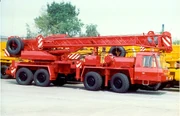
Kenworth cab-over dump truck

Tatra T815 8x8 cab-over-in-front autocrane

Land Rover 101 Forward Control with radio-vehicle body
Cab-over, also known as COE (Cab Over Engine), cab forward, or forward control, is a body style of truck or van that has a vertical front or "flat face", with the cab of the truck sitting above the front axle. This truck configuration is currently common among European and Japanese truck manufacturers, because the laws governing overall vehicle lengths are strict and the body style allows longer trailers or a longer cargo area for the same overall length.
Although popular among United States heavy truckers and trucking companies during the 1970s because of strict length laws in many states, when those length laws were repealed, most heavy-truck makers moved to other body styles. It is, however, still very popular in the light- and medium-duty truck segment, with models such as the Isuzu NPR series or the Mitsubishi Fuso FE and FK/FM series.
Most Japanese minivans like the Suzuki Carry, Toyota Hiace and Mitsubishi Delica also use this body layout. It was also used for the (rear engined) Volkswagen Type 2 van, and in military vehicles such as the Land Rover 101 Forward Control and the Pinzgauer High Mobility All-Terrain Vehicle.
History[]

Vintage COE: 1942 Chevrolet
The Sternberg company of Wisconsin produced cab-over trucks as early as 1907, though by 1914 only their seven-ton model was a cab-over. They reintroduced the cab-over layout in 1933 with their "Camel Back" model, which allowed the cab to be tilted to access the engine.[1]
The introduction of the first modern cab-over layout in the U.S. is credited to industrial designer Viktor Schreckengost, who with engineer Ray Spiller designed a cab-over truck for the White Motor Company in 1932.
The laws of the time limited truck length to 42 feet (12.8 m) on highways. Siting the cab over the engine saved several feet of cab length, which was added to the trailer capacity. Schreckengost patented the design in 1934.
White-Freightliner introduced its first tilting cab-over design in 1958, which allowed the entire cab to tilt forward for access to the engine.[1]
Advantages[]

1970s Mercedes-Benz truck with tilting cab
In Class 8 tractors, the cab-over design allows the vehicle's wheelbase to be shorter than in the conventional arrangement, wherein the engine is placed in front of the cab, covered by a horizontal or sloping hood that opens to allow engine access. Its shorter wheelbase allows cab-over semi trucks to have a shorter overall length, thereby allowing for longer trailers to be used. For light- and medium-duty solid- or rigid-axle trucks, the cab-over design requires less length for the cab and engine, in a given wheelbase, and therefore allows a greater length for the truck body or load area.
In both class 8 tractors and light- and medium-duty solid-axle trucks, the cab-over-engine design gives the COE model an advantage in maneuverability over a conventional model. And since COEs are generally lighter than conventionals, they can often haul heavier loads, given equal GVWRs (gross vehicle weight rating) and GCWRs (gross combination weight rating). Despite the COE designs' being smaller in general, over-the-road tractors can still be fully equipped with single or bunk beds. Also, lack of a hood gives better visibility to the driver, tighter turning radius and significantly reduces the forward blind spots.
Disadvantages[]
Some drivers have complained, however, that the shorter wheelbase in the COE semi-trucks gives a rougher ride than those with conventional cabs, as the driver's seat is above the front axle; and that the cabs tend to be noisier because the engine is directly below, though some of this is dependent on the amount of noise-dampening insulation used in the construction of the individual vehicle.
Because of their flat front design, early COE semi-trucks had significantly worse aerodynamics than conventional tractors. Modern cab-over designs, in both semi-trucks and light- and medium-duty models, have improved aerodynamics significantly over early models, but often still have higher drag coefficients than their modern conventional-design counterparts. This works against fuel economy, and offsets some of the improvement in fuel consumption garnered from the lighter weight of the cab-over truck when running less than fully loaded.[citation needed]
Although the tilting cab gives comparatively unobstructed access to the engine, its deployment causes unsecured items in the cab and sleeper (if equipped) to fall onto the windshield or under the instrument panel. [2]
Safety[]
In early cab-over models, the lack of a safe crush zone in the front made them far more dangerous in the event of a crash.[citation needed] However, modern designs employ stiffening beams in the doors to help prevent collapse during a front-end collision, steering columns are typically collapsible, all models include seat belts, and some models are equipped with airbags. All of these features improve occupant safety during a collision.
See also[]
References[]
| This page uses some content from Wikipedia. The original article was at Cab over. The list of authors can be seen in the page history. As with Tractor & Construction Plant Wiki, the text of Wikipedia is available under the Creative Commons by Attribution License and/or GNU Free Documentation License. Please check page history for when the original article was copied to Wikia |
- ↑ 1.0 1.1 Holtzman, Stan (1995). American Semi Trucks. MBI Publishing Company, 82–85. ISBN 0760300380.
- ↑ Richards Award Winning Kenworth Cabover